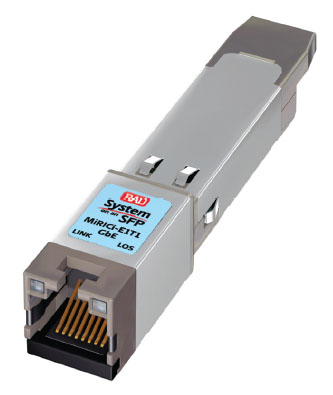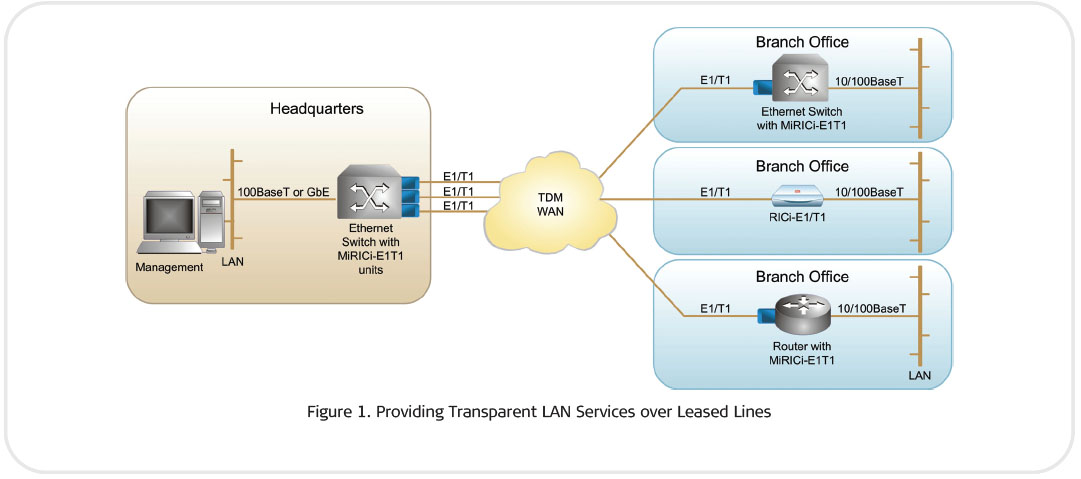
RAD
MiRICi-E1T1 Intelligent Miniature Ethernet to E1/T1 Remote Bridge
SFP-Format

MiRICi-E1T1 Intelligent Miniature Ethernet to E1 / T1 remote bridge from RAD offers a lot in a very small package connecting Fast or Gigabit Ethernet LANs over framed E1 or framed/unframed T1 links.
Key points of this RAD product include:
• Providing E1/T1 connectivity to any Ethernet device with SFP MSA-compatible socket
• Full duplex, E1/T1 wire-speed packet forwarding
• Supports GFP, RAD HDLC and cHDLC encapsulation
• Fault propagation to LAN link
• Inband and out-of-band management for configuration, monitoring and diagnostics
• I2C management interface for simple management integration with host devices
MiRICi-E1T1 forwards Fast or Gigabit Ethernet packets to a TDM-based WAN at full duplex wire-speed, fully utilizing the expensive E1 or T1 TDM bandwidth. The TDM interface type (E1 or T1) is user-configurable. MiRICi-E1T1 uses GFP, RAD HDLC and cHDLC encapsulation protocols. Housed in a Small Form Factor Pluggable (SFP) package, MiRICi-E1T1 complies with the Multi-Source Agreement (MSA).
The unit supports the following frame sizes, including VLAN-tagged frames:
• 64–2016 bytes for Fast Ethernet
• 64–10000 bytes for Gigabit Ethernet.
LAN traffic is transparently directed, thus preserving the user LAN settings. All parameters
are software-configurable including transmit timing sources and data formats.
Management of the RAD MiRICi-E1/T1
The unit can be monitored, configured, and tested using the following ports and applications:
• Out-of-band via the I2C channel (off the SFP edge connector)
• Inband via the Ethernet port using a Web browser. Supports sending SNMP traps for up to
eight management stations.
LOS and Fault Propagation with the RAD MiRICi-E1/T1
The LAN link is deactivated and the link status LED turns off if one of the following
user-defined alarms is issued and fault propagation is enabled:
• LOS (Loss of signal)
• FDL (Facility Data Link)
• LOF (Loss of Frame)
• AIS (Alarm indication signal)
• RDI (Remote defect indication).
In addition, the above-listed error conditions are propagated towards the host by sending an electrical signal via the
LOS pin on the MSA edge connector. The LOS LED turns ON, visually indicating the
LOS condition.
RAD MiRICi-E1/T1 Encapsulation
MiRICi-E1T1 supports the GFP, RAD HDLC and cHDLC WAN encapsulation protocols.
MiRICi-E1T1 Intelligent Miniature Ethernet to E1/T1 Remote Bridge Flow
Control
A flow control mechanism is activated when LAN traffic exceeds the WAN link (E1, T1) capacity and the watermarks of
the internal frame buffer. Pause packets are transmitted to the LAN port, halting
LAN traffic until the buffer is emptied to below the watermark limit.
Quality of Service (QoS) provided by RAD MiRICi-E1T1
MiRICi-E1T1 facilitates differentiated services on the same link according to Ethernet or IP marking. Classification is
based on VLAN priority (802.1p), while the traffic is forwarded by four strict priority
queues.
MiRICi-E1T1 Diagnostics and Loop Detection
Remote (RLB) and local loopbacks (LLB) are used for physical layer troubleshooting.
MiRICi-E1T1 incorporates a mechanism
that detects loops on the LAN side or WAN side by transmitting special loop detection frames.
When the unit recognizes that a loop exists, it reacts accordingly:
• If a loop is detected on the LAN side, a loop detection alarm is sent
• If a loop is detected on the WAN side, the unit blocks the traffic and loop detection alarm is also sent.
MiRICi-E1T1 Clock Options
MiRICi-E1T1 supports Tx clock sources for the internal and receive clocks. Standard statistics for 15 minute time
intervals are collected.
Bridge Flexibility
MiRICi-E1T1 operates opposite the following devices using GFP, RAD HDLC and cHDLC encapsulation:
• RAD’s Egate-20, Egate-100 (central Ethernet gateway)
• RAD’s RICi-16, RICi-E1 and RICi-T1
• Third-party devices that support GFP,
RAD HDLC and cHDLC encapsulation.
SFP enclosure for multiple Ethernet MiRICi-E1T1 bridges
MiRICi-E1T1 complies with the Multi-Source Agreement (MSA).
Running on power derived from the host device, it requires no additional power supply.
MiRICi-E1T1 is hot swappable and features a special release mechanism for easy extraction from the SFP socket.
Possible applications
• Transparent LAN services over leased lines
• Remote branch connectivity over E1/T1 lines
• Connecting LANs over E1/T1 radio links or in campus applications.
• Used by CLECs in remote
enclosures
SFP configuration adapter
An optional configuration adapter module, SFP-CA, is available for configuring MiRICi-E1T1 by connecting it to a PC via a
USB port.
The configuration adapter is used for preliminary configuration such as assigning an IP address for first use or
specifying the operation mode. It is also used to download software to the MiRICi-E1T1 units.
Figure 1. Providing Transparent LAN Services over Leased Lines

MiRICi-E1T1 Intelligent Miniature Ethernet to E1/T1 remote bridgedata sheet ![]()